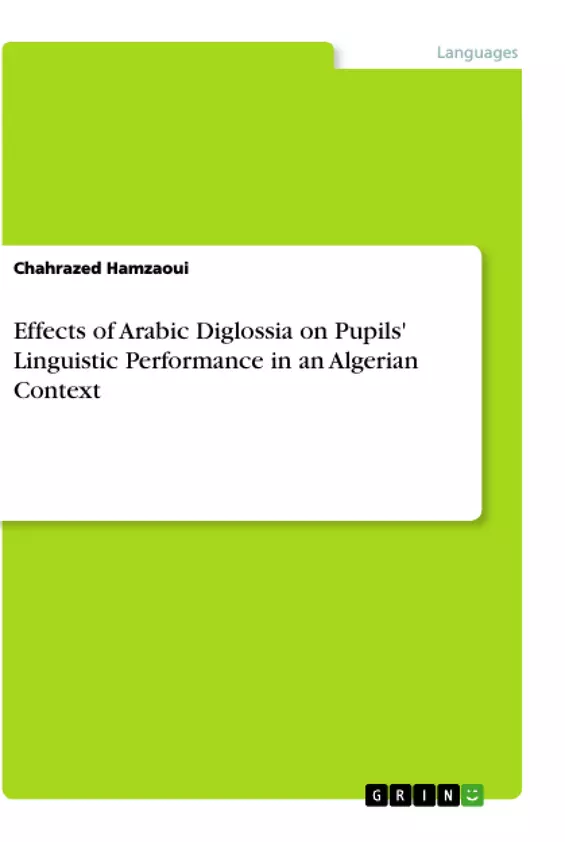The purpose of this study is to investigate the impact of Arabic diglossia on formal instruction with special reference to the primary level in Tlemcen schools. It seeks to highlight the sociolinguistic phenomenon ‘diglossia’ and its effect on pupils’ linguistic performance. Recently, clear flaws seem to have been noted in pupils’ linguistic skills in all Arab schools, particularly in first grade level, since most of them have relatively little or no contact with the official language of instruction before formal schooling. In the Algerian policy, Modern Standard Arabic (MSA hereafter) is the language used in classroom settings.
However, it is generally agreed among educationists, that the achievement of low levels is mainly linked to the complexities of the literary language used in formal instruction and the various colloquial forms reserved for non-formal contexts. Children acquire Algerian Arabic as a mother tongue, while Standard Arabic is learned later on through access to formal instruction. The pupils’ educational problems and the persistent feelings of linguistic insecurity are directly attributed to diglossia. Through collecting and analyzing data by means of a number of sociolinguistic tools, the researcher tried, in this study, to compare between two school settings to show the extent to which diglossia affects the learning process among first grade pupils by: exploring the variety used in classroom interaction, insisting on the language difficulties encountered by young pupils and detecting their attitudes towards the forms of Arabic used in classroom interaction.
Inhaltsverzeichnis (Table of Contents)
- Abstract
- List of Abbreviations and Acronyms
- Chapter 1: Introduction
- 1.1. The problem of the Study
- 1.2. Statement of the problem
- 1.3. Objectives of the study
- 1.4. Research questions
- 1.5. Significance of the study
- 1.6. Delimitations of the study
- 1.7. Limitations of the study
- 1.8. Definitions of terms
- Chapter 2: Theoretical Framework
- 2.1. Diglossia
- 2.2. Arabic Diglossia
- 2.3. The Arabic language and its varieties
- 2.4. The Arabic language in Algeria
- 2.5. Sociolinguistic factors affecting language learning
- 2.6. Attitudes towards language varieties
- Chapter 3: Methodology
- 3.1. Research Design
- 3.2. Population and Sample
- 3.3. Data Collection Techniques
- 3.4. Data Analysis Techniques
- Chapter 4: Results and Findings
- 4.1. Analysis of the language used in classroom interaction
- 4.2. Analysis of the language difficulties encountered by pupils
- 4.3. Analysis of the attitudes towards the forms of Arabic used in classroom interaction
- Chapter 5: Discussion
- 5.1. Discussion of the findings
- 5.2. Implications for education
Zielsetzung und Themenschwerpunkte (Objectives and Key Themes)
This study aims to investigate the impact of Arabic diglossia on the formal instruction of primary school students in Tlemcen, Algeria. The study seeks to highlight the sociolinguistic phenomenon of diglossia and its effect on pupils' linguistic performance. The study seeks to determine the extent to which diglossia affects the learning process among first-grade pupils.
- The impact of Arabic diglossia on pupils' linguistic performance in primary school.
- The sociolinguistic phenomenon of diglossia and its effects on language learning.
- The variety of Arabic used in classroom interaction.
- The language difficulties encountered by pupils in the learning process.
- The attitudes of pupils towards the forms of Arabic used in classroom interaction.
Zusammenfassung der Kapitel (Chapter Summaries)
Chapter 1: Introduction introduces the problem of the study, the research questions, the objectives, the significance, the delimitations, and the limitations of the study. It also provides definitions of key terms.
Chapter 2: Theoretical Framework provides a theoretical background to the study, focusing on the concept of diglossia, Arabic diglossia, the Arabic language and its varieties, the Arabic language in Algeria, sociolinguistic factors affecting language learning, and attitudes towards language varieties.
Chapter 3: Methodology describes the research design, population and sample, data collection techniques, and data analysis techniques used in the study.
Chapter 4: Results and Findings presents the findings of the study, including an analysis of the language used in classroom interaction, the language difficulties encountered by pupils, and the attitudes towards the forms of Arabic used in classroom interaction.
Chapter 5: Discussion provides a detailed discussion of the findings of the study, highlighting their implications for education.
Schlüsselwörter (Keywords)
The key focus of this study is the impact of Arabic diglossia on pupils' linguistic performance in primary school. The study investigates the use of various forms of Arabic in the classroom and their effect on student learning. It also examines the sociolinguistic factors contributing to the observed difficulties, including the students' attitudes towards different varieties of Arabic.
- Quote paper
- Chahrazed Hamzaoui (Author), 2021, Effects of Arabic Diglossia on Pupils' Linguistic Performance in an Algerian Context, Munich, GRIN Verlag, https://www.grin.com/document/1003571



